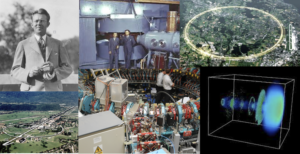
(Last updated July 15, 2020 by Eric Prebys)
NOTE: For all the linked files on this page, right-click->Save… won’t work properly. You must left-click, then select “Download” after the page loads.
Contents
What’s New
- July 15, 2020
- Final Q&A session
- Course officially done!
General
This is an online version of the USPAS “Accelerator Physics Fundamentals” Course, which is being recorded after the live USPAS scheduled for June 2020 was canceled over COVID-19 concerns.
The lectures largely followed the course as I gave it in June, 2018, which can be found here, although the lectures were slightly updated and re-posted. It obviously did not include the lab sessions, so it was be roughly half the length of the original course. Homework assignments were posted, along with solutions, but were not graded.
Live Q&A Sessions
There were live Q&A sessions from noon-2 PDT: Wed. July 1, Mon. July 6, Wed. July 8, Fri., July 10, 2020, and Wed. July 15th.
Recorded sessions:
- July 1, 2020
- July 6, 2020
- Forgot to record July 8, 2020
- July 10, 2020
- July 15, 2020
Text and Reference Material
The text for the course will be Edwards and Syphers, “An Introduction to the Physics of High Energy Accelerators”. An online version can be found here (posted with permission of the authors).
Other texts and resources are discussed in the “Formalities” lecture, below.
Software
This course will use the MADX and G4Beamline programs for a couple of the homework problems.
MADX is a standard program for accelerator modeling. It is supported for Windows, MacOS, and most linux systems. You can download the version appropriate to your system from here (use the “-gnu” version). This is a standalone executable program, designed to run in a command window, so on Macs and Linux systems, you’ll need to do “>chmod +x (filename)” before running it. The graphic out put is in PostScript. This can be viewed directly with the Mac Preview utility, but on Windows and Linux Systems, you’ll need to download and install PDFCreator to convert it to PDF, or alternatively you could install GhostScript and GhostView.
G4Beamline is a scripted version of the GEANT4 simulation package, which is starndard for HEP detector simulation. You can download the program here. It is supported for Windows, MACOs and linux. The first time you run the program, it will download quite a bit of data the GEANT needs for simulation.
The output of G4Beamline is in ROOT files. If you are familiar with ROOT, you make analyze them directly. Otherwise, a GUI HistoRoot program can be found here. Note that HistoRoot requires a specific version of ROOT, which can be downloaded at the same location.
Lectures
Full playlist of videos here.
Lectures 0-5 constitute the core of the course, while the remaining lectures are an assortment of topics that rely on some or all of the earlier lectures. For those lectures, I have listed the specific prerequisites from among the earlier lectures.
Individual Lectures (Note: these vary greatly in length.):
- Lecture 0: Formalities (pptx,pdf,video of lecture)
- Lecture 1: Overview (pptx,pdf,video of lecture)
- Lecture 2: Expectations, Relativity, and E&M (pptx, pdf,video of lecture)
- Lecture 3: Transverse Motion (pptx, pdf, video of slides 1-36, video of slides 37-73)
- Note: there’s a sign error on the Bx vs y plot on slide 4 in the recorded lecture (fixed in the slides)
- Lecture 4: Off-Momentum Particles (pptx,pdf,video of lecture)
- Lecture 5: Longitudinal Motion (pptx,pdf,video of lecture)
- Lecture 6: Closed Orbit Distortions and Local Bumps (pptx, pdf, video of lecture)
- Prerequisites: 0-3
- Lecture 7: Matching and Insertions (pptx, pdf, video of lecture)
- This includes collision regions for colliders
- Prereqisites: 0-4
- Lecture 8: Tricks of the Trade(pptx, pdf,video of lecture)
- Kind of a grab bag of topics that don’t really fit anywhere else, including
- multi-stage acceleration
- luminosity at colliders, which might be of interest to LHC people.
- orbit corrections
- secondary beams
- Prerequisites: 0-5
- Kind of a grab bag of topics that don’t really fit anywhere else, including
- Lecture 9: Synchrotron Radiation and Light Sources (pptx,pdf, video of lecture)
- Prerequisites: 0-5
- Lecture 10: Resonances and Coupling (pptx, pdf, video of lecture)
- Prerequisites: 0-3
- Lecture 11: Collective Effects (pptx,pdf, video of lecture)
- Prequisites: 0-3
- Lecture 12: Cyclotrons and Crocker Nuclear Laboratory (pptx, pdf, video of lecture)
- Prerequisites: 0-3
- Lecture 13: Linacs (pdf)
- Guest lecture given by Nicole Neveau at the June 2018 USPAS session.
- There will be no recorded version of this lecture.
- Prerequisites: Mostly 5
Homework
- HW#1 (through Lecture 2)
- HW#2 (through first part of Lecture 3)
- HW#3 (through Lecture 3)
- HW#4 (through Lecture 5)
- main_ring.g4bl
- If you use ROOT rather than HistoRoot, you may find these files useful
- Solutions
- main_ring.g4bl
- HW#5 (through Lecture 5)
- HW#6 (through Lecture 6)
- HW#7 (through Lecture 9)
Recent Comments